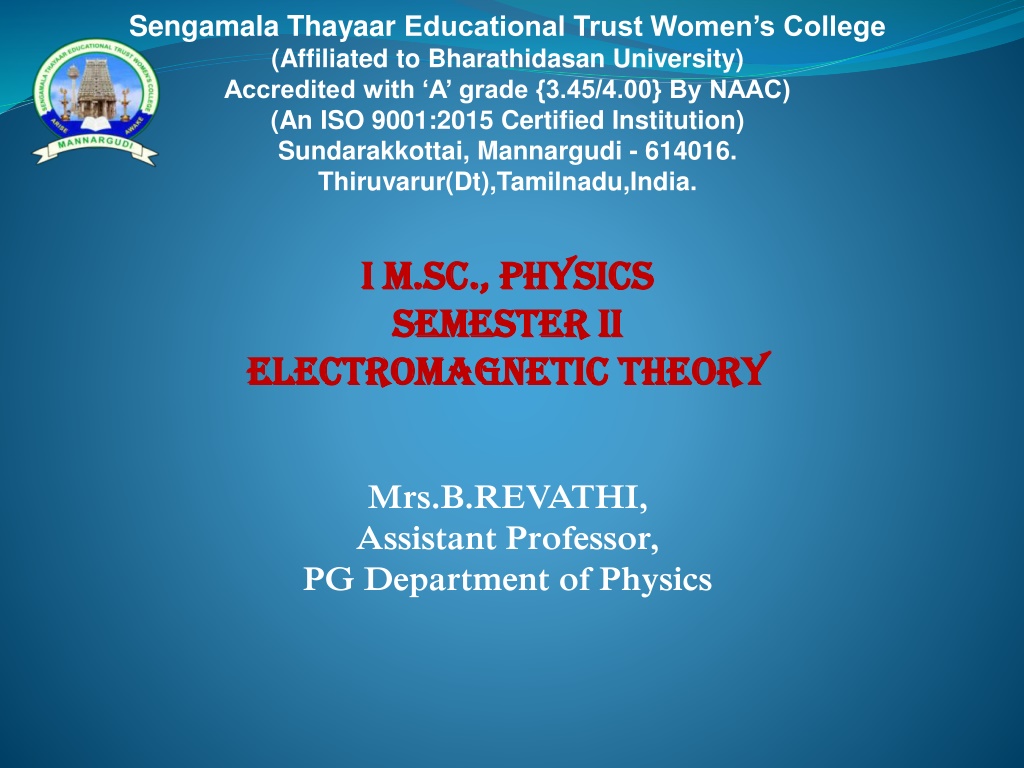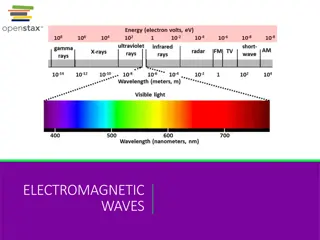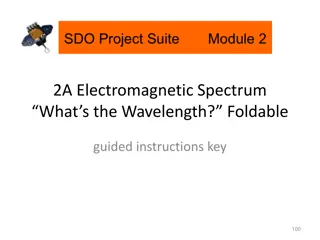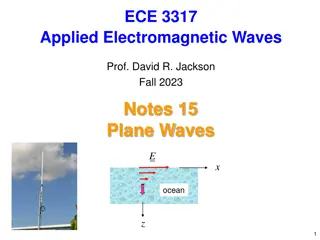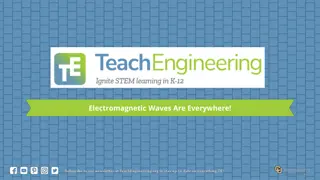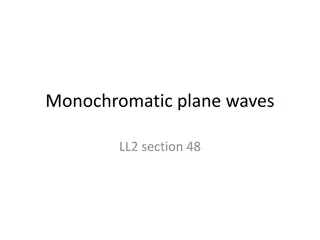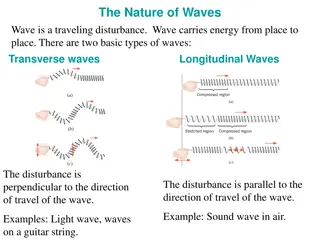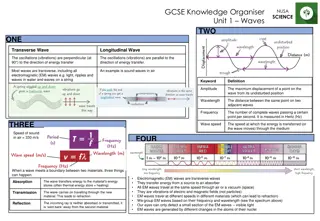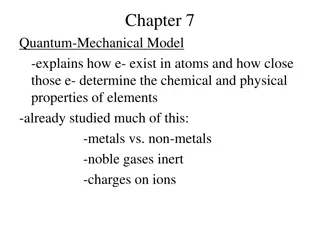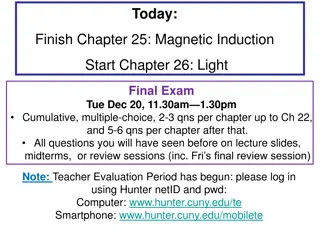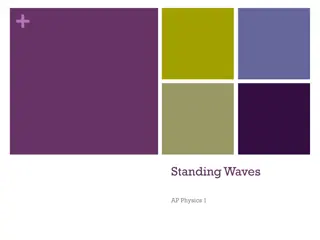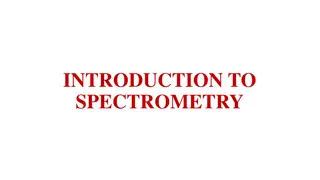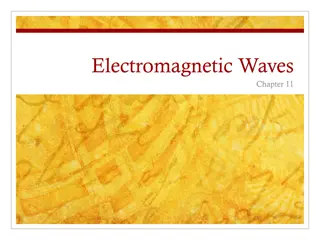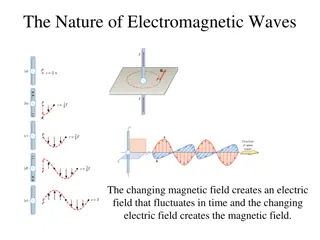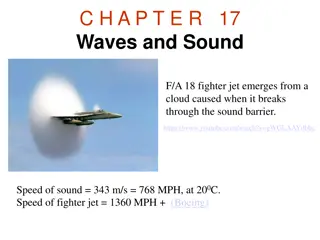Understanding Electromagnetic Waves in Physics
Exploring the propagation of electromagnetic waves in different mediums such as free space and isotropic dielectrics. Discusses Maxwell's equations, wave equations, transverse nature, energy transmission, and impedance in electromagnetic wave propagation.
Download Presentation

Please find below an Image/Link to download the presentation.
The content on the website is provided AS IS for your information and personal use only. It may not be sold, licensed, or shared on other websites without obtaining consent from the author. Download presentation by click this link. If you encounter any issues during the download, it is possible that the publisher has removed the file from their server.
E N D
Presentation Transcript
Sengamala Thayaar Educational Trust Womens College (Affiliated to Bharathidasan University) Accredited with A grade {3.45/4.00} By NAAC) (An ISO 9001:2015 Certified Institution) Sundarakkottai, Mannargudi - 614016. Thiruvarur(Dt),Tamilnadu,India. I M.SC., PHYSICS I M.SC., PHYSICS SEMESTER II SEMESTER II ELECTROMAGNETIC THEORY ELECTROMAGNETIC THEORY Mrs.B.REVATHI, Assistant Professor, PG Department of Physics
PLANE ELECTROMAGNETIC WAVES AND THEIR PROPAGATION Electromagnetic Waves in free space We know that Maxwell's equations are
Electromagnetic Waves in free space So Maxwell's equations reduce to The above equation are standard wave equation representing unattenuated wave traveling at a speed u.
Electromagnetic Waves in free space i.e. the velocity of light.
Electromagnetic Waves in free space In case of propagation E. M. W. in free space. The wave propagates with a speed equal to that of light in free space. The electromagnetic waves are transverse in nature. The wave vectors E and Hare mutually perpendicular. The vector E and H are in phase. The electromagnetic energy is transmitted in the direction of wave propagation The electrostatic energy density is equal to the magnetostatic energy density
PROPAGATION OF E.M.W IN ISOTROPIC DIELECTRICS We know that Maxwell's field equations are and in isotropic dielectrics So Maxwell s equation reduce to
PROPAGATION OF E.M.W IN ISOTROPIC DIELECTRICS The speed of electromagnetic wave in isotropic dielectric is less than the speed of electromagnetic waves in free space. The vector E and H are orthogonal i.e.the electromagnetic wave is transverse in nature and in the dielectric electric and magnetic vectors are also mutually orthogonal
PROPAGATION OF E.M.W IN ISOTROPIC DIELECTRICS The vector E and H are in phase and their magnitudes are related to each other by the relation Z is called the impendence of the medium The direction of flow of energy is the direction in which the wave propagation and the poynting vector is n times of the poynting vector if the same wave propagates, through free space
PROPAGATION OF E.M.W IN ISOTROPIC DIELECTRICS The electromagnetic energy density is equal to the magnetostatic energy density and the total energy density r times of the energy density if the same wave propagates through free space.
Reflection and refraction of E.M.W When an electromagnetic wave hits a boundary between different materials, some of the wave s energy is reflected back while the rest continues on through the second material, although the direction of the continuing wave may be somewhat different from the original wave s; this bending of the wave s direction is called the refraction.
Reflection and refraction of E.M.W The kinematic relations between the directions of the incident, the refracted, and the reflected waves. The dynamical relations between the intensities, the phases, and the polarizations of all the waves
Reflection and refraction of E.M.W Kinematic Properties: Law of Frequency: The frequency of the wave remains unchanged by reflection or refraction The reflected and refracted waves are in the. same plane as the incident wave and the normal to the boundary surface. Law of reflection: In case of reflection the angle of reflection is equal to the angle of incidence.
Reflection and refraction of E.M.W Snell s Law : In case of refraction the ratio of the sin of the angle of refraction to the sin of angle of incidence is equal to the ratio of the refractive indices of the two media. Dynamic properties: Intensities of reflected and refracted waves Phase changes and polarization of waves
WAVE GUIDE A hollow metallic tube of uniform cross section for transmitting electro magnetic waves by successive reflections from inner walls of the tube is called Waveguide.
WAVE GUIDE Waveguide may be used to carry energy between pieces of equipments. Waveguides are made from Copper, Aluminium. TYPES OF WAVE GUIDE 1.RECTANGULAR WAVEGUIDE 2.CIRCULAR WAVEGUIDE
RECTANGULAR WAVEGUIDE RECTANGULAR WAVEGUIDE Dominant mode is TE10 Supports TE and TM waves but not TEM waves There is only one conductor Bands between 1GHz
CIRCULAR WAVEGUIDE CIRCULAR WAVEGUIDE It support both transverse TE and TM modes. The dominant mode is TE11 It is easily manufacture than rectangular waveguides. It is usually used to connect a horn antenna with a reflector in tracking radars and for long distance wave guide transmission as 10 GHz.
TE &TM MODES TE mode: This waveguide mode is dependent upon the transverse electric waves, also sometimes called H waves, characterised by the fact that the electric vector (E) being always Perpendicular to the direction of propagation. TM mode: Transverse magnetic waves, also called E waves are characterised by the fact that the magnetic vector (H vector) is always perpendicular to the direction of propagation.
TE &TM MODES TEM mode: The TEM wave is characterised by the fact that both the electric vector (E vector)and the magnetic vector (H vector) are perpendicular to the direction of propagation.
APPLICATIONS To reduce Attenuation loss. Can operate only above certain frequencies Short and medium communication distance broad band
CAVITY RESONATOR An electronic device consisting of a space usually enclosed by metallic walls within which resonant electromagnetic fields may be excited and extracted for use in microwave systems.
TYPES TYPES OF OF CAVITY CAVITY RESONATOR RESONATOR Regulated Cavity Resonator. Un Regulated Cavity Resonator. Co-axial Cavity Resonator. Capacitive Cavity Resonator. Inductive Cavity Resonator. Waveguide Cavity Resonator. Reentrant Cavity Resonator.
APPLICATIONS Cavity resonators are widely used as the frequency determining element in microwave oscillators. Waveguides are used at the highest frequencies to transmit power and signals. Similarly, cavity resonators are employed as tuned circuits at such frequencies.
